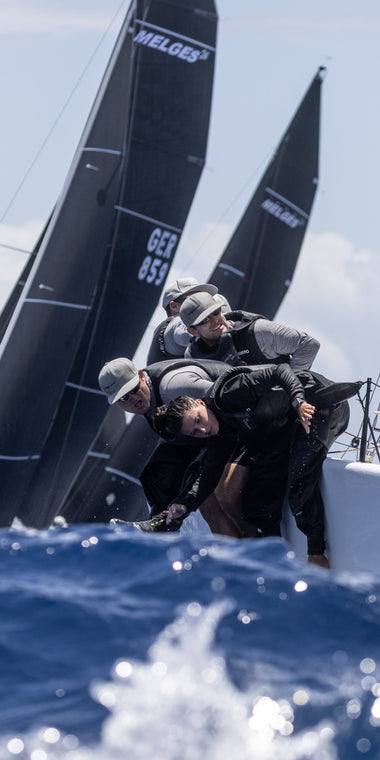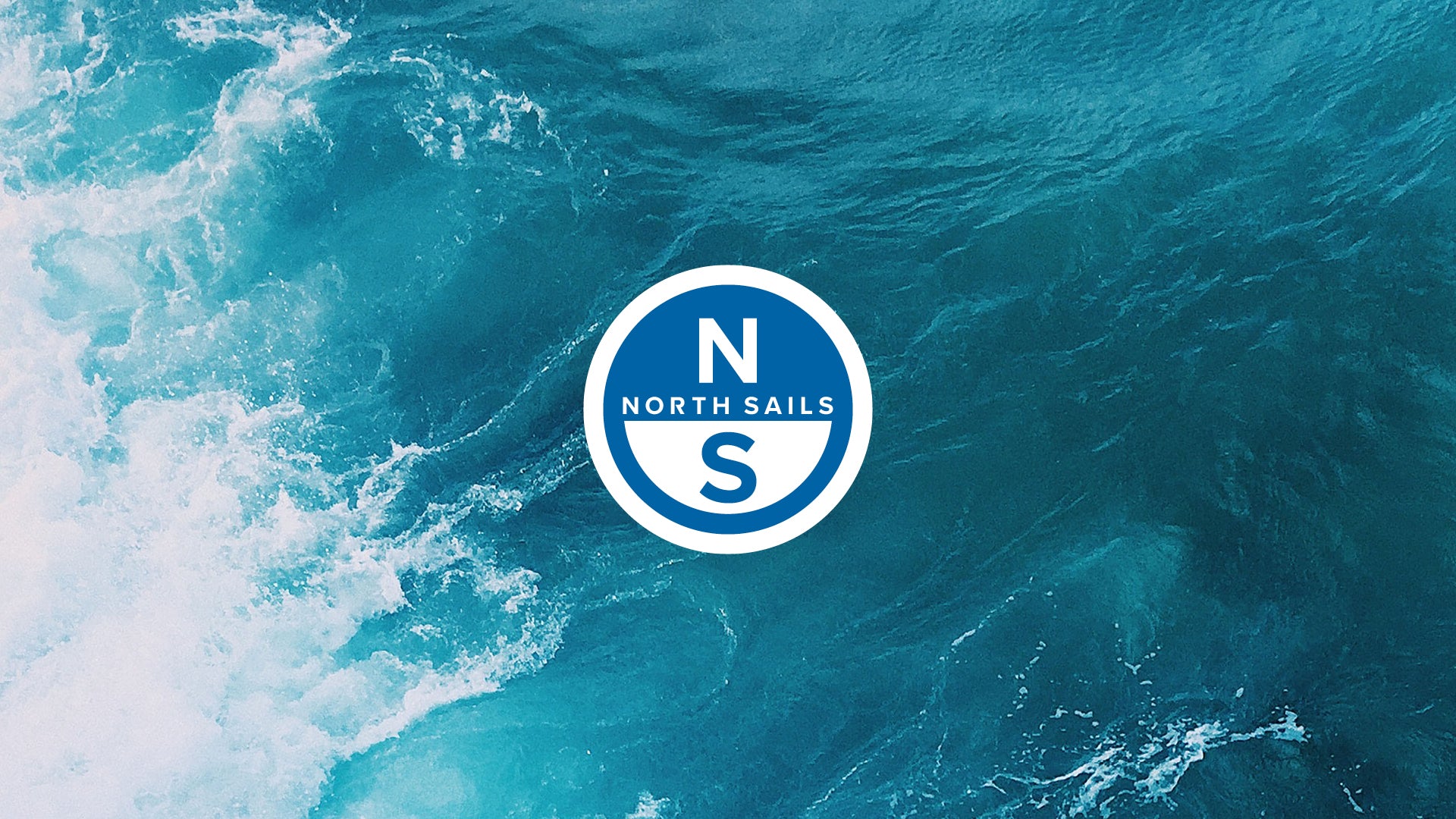J105 SPEED GUIDE
Who sails a J105?
As the first keelboat with a retractable bowsprit, the J105 was a breakthrough when Rod Johnstone designed it for J/Boats in 1991, and nearly 700 boats were built. Because it has relatively small jibs and spinnakers and a displacement hull, the boat is easy to sail, yet it still delivers excitement in a breeze. Teams frequently include more women and youth sailors than other classes, and we find that it’s a great platform for a sailor with modest experience who wants to compete, but doesn’t have a super crew pool to start.
If you climb aboard with three sails and an enthusiastic crew, you can quickly learn to jibe the chute. It takes a while to learn to get the most out of the boat when it’s underpowered, under 10 knots of wind, but that may be why the best sailors in this class tend to be the most persistent, gradually becoming more competitive. The class has restrictions on pros participating, which has combined with the boat’s simplicity, all-around performance, and large fleet to give it staying power as a class.
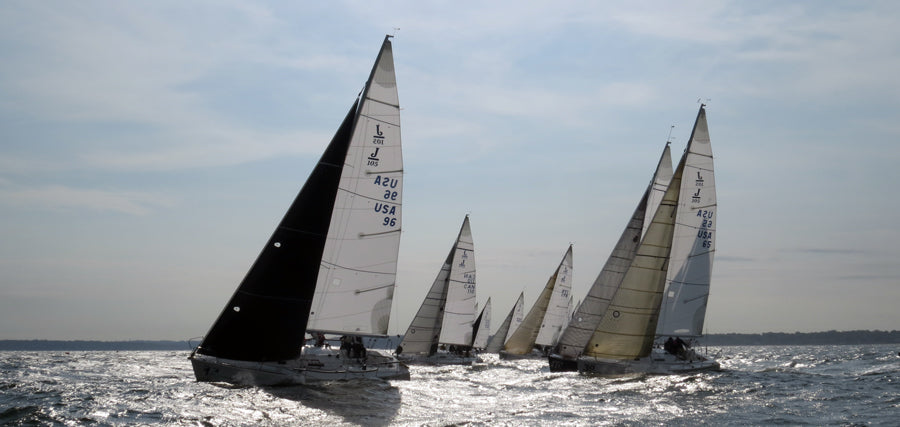
The J105 combines simplicity with all-around performance and large fleets.
What’s involved in crewing?
Most teams sail with five or six sailors, and they include many husband-wife teams. There is no limitation on the number of sailors aboard; the total crew weight allowed is 474 kilograms or 1,045 pounds. In windy venues, such as San Francisco Bay, most teams sail at maximum weight, and those with less weight and less strength make up for it by adding the sixth person.
We recommend recruiting a strong bow person to work the spinnaker around in jibes and pull it down at the leeward mark, and if they’re a little heavier than the typical bow person, it doesn’t seem to slow the boat down. On the other hand, the winches are adequately sized and the mainsail has enough purchase, so trimming isn’t overly physical, which means for those farther aft, quickness and the agility to move around is often more important than strength.
Top three J105 speed tips?
Spend time in the boat with a committed core crew.
Learn appropriate sail trim and rig tune, especially when windy.
Prep the hull and rig, clean the bottom, and save your best sails for big events.
What should buyers know when choosing a J105?
J/Boats isn’t building new boats currently due to low demand. Used boat prices range from $45,000-$90,000, and most are between $60,000 and $70,000. On older boats, you’ll commonly replace winches, the boom, and maybe the sprit.
We see that top competitors in the class often seek an older boat built before production shifted to the SCRIMP (resin-infusion) method, because the boats
are considered a little stiffer, with less weight in the hull and deck. By rule, the first 400 pounds of corrector weights on light boats can be added down low, although not in the keel sump. J/Boats points out that this “class wisdom” may be overstated because much of the SCRIMP boats’ weight is in a substantially heavier keel grid. They also point out that the hulls have more laminate stiffness and are less susceptible to water penetration in the core, particularly in the deck—a problem that needs to be addressed in many older boats.
One of the other big decisions is whether to buy a boat with a wheel or tiller. Many like using tiller steering due to its lighter weight and feel, but in a heavy-air locale, almost everyone chooses wheel steering for better control. Both configurations win regattas, so our recommendation is that you choose whatever you are most comfortable using.
Finally, it’s worth noting that J/Boats built a number of shoal-draft J105s over the years; you’ll want to buy one with a deep-draft keel to go racing.
How do you move a J105 around to regattas?
Double-axle J105 trailers are prolific in many regions as owners commonly trailer boats to events. If needed, you can often borrow a trailer. It’s not unusual for boats from both New England and California to meet at a regatta in the middle of the country. That doesn’t mean that rigging a boat is super quick. It takes most boat crews a day to get a boat ready to travel and another day to go back in the water.
How many sails are required?
The J105 class allows you to sail with two jibs, two spinnakers and one main, but the spinnakers are identical, so the second is typically an older kite kept as a spare. Sails can be changed between races, so a boat with a light and medium jib will switch sails as the breeze builds. In broad terms, a light-air jib is used in 0 to 10 knots, the medium covers 8 to 16, and the heavy can be used in 14 and above.
If the water is relatively flat, the medium jib will provide good speed in most winds strong enough to start a race. Because boats often come with a large inventory of used sails, many new owners find they can buy a new main, spinnaker and medium jib and be competitive, with older sails used for low-key races or daysailing.
The class sail-purchase limits are reasonably liberal. You can buy three sails in one year and then two sails, the next. The mains must be made of woven Dacron and may be made of heavier cloth for windy venues like San Francisco where they are subject to a fair amount of flogging. Laminated jibs are permitted, which includes recent approval for North’s more durable 3Di sails—both medium and light-air jibs. (
See North’s J105 sail products
)
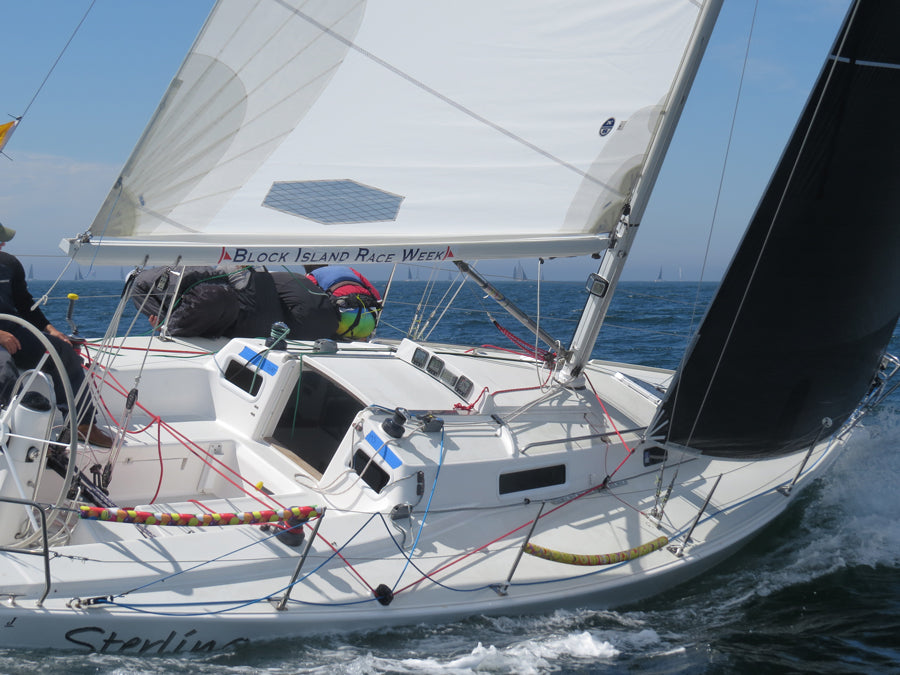
Leading the jib sheet to the windward winch keeps weight on the high side and allows the mainsheet trimmer to adjust the trim.
J105 Tuning
What are the keys to rig set-up?
When tuning up the J105 to race, we pay the most attention to 1) mast-butt position, 2) headstay sag, and 3) shroud tension on the D1 (lower), D2 (intermediate), cap (upper).
There is only one correct butt position, so you only need to set that once, as per the
. The guide also explains how to adjust each set of shrouds for different wind strengths. We stress learning about this because shroud tension affects headstay tension and how much the headstay sags under different loads.
Getting headstay sag right is also a little finicky, because the mast sits at different heights from boat to boat, varying by as much as 25mm due to the way the interior pan goes into the hull. To determine your headstay sag, we recommend sighting up the headstay with the backstay off —no more than 4 inches when it’s breezy and closer to 6 inches in light air. If you’re flying a medium jib in light air, you may need more sag, yet not so much that the headstay begins to bounce around in chop. Having enough sag in light air gives power to your jib, but if you have too much and you control it by tensioning the backstay as the wind comes up, you’ll end up over-flattening your main.
Shroud tension also affects mid-mast sag. In lighter airs, you want less tension on the D1 and D2 shrouds so you can see 25 mm of leeward sag in the middle of the mast. In 12 knots and up, you’ll want no sag at all.
What other control systems are important on the J105?
Setting up to cross-sheet the jib (and then practicing your tacks) is critical in windy conditions, as is having good leverage on the vang. You are not allowed to in-haul the jib with the windward sheet, so that simplifies things somewhat. Mainsheets have fine tunes and you’ll find some variation. For example, some are led outboard so the helmsman can play the fine tune. Our view is that this is an area of personal preference and probably not a high priority for you if you’re a new J105 helmsperson. Let the mainsail trimmer handle the job while you focus on steering.
For more tuning tips, read the J105 Tuning Guide
Headstay sag on the J105 is adjusted by means of shroud tension; the sag should be about 6 inches in light air and no more than 4 inches when breezy.
J105 Upwind Sailing
How much heel is fast on a J105?
In general, you should sail the boats pretty flat. A skilled driver will keep it flatter, but most important is to maintain a constant heel angle and consistent speed. If you need more heel to maintain consistency, that’s OK.
Where does the crew sit?
The boats are a bit stern heavy, so we always work to keep people forward and out of the cockpit. This is especially true with wheel boats, which have extra weight aft. If sailing with six, locate one person forward of shrouds; everyone else should be forward of the back edge of the cabinhouse; if sailing with five, sit the forward-most three close together, just behind the shrouds, followed by the mainsheet trimmer when he or she is able to get on the rail.
When the wind lightens, there’s no fore-and-aft position change, just lateral movement, with the jib trimmer moving to leeward first. When possible, we move everyone a half a body width farther forward, with the mainsail trimmer scooting to the front of the cockpit. In heavier air, bring the forward-most person behind the shrouds to keep weight at max beam.
How do you trim the J105 jib?
The key move we make with the jib is to keep halyard tension soft, especially with new jibs. Be sure to put trim stripes on the spreaders as per the
.
The jib likes to be kept twisted, with the leech opened up slightly even as the sheet is trimmed pretty hard. Above 10 knots, you will sheet hard enough that you may begin to get a wrinkle between the tack and the clew.
Watching for that is a good way to judge sheet tension. Many people move the lead too far forward because the foot looks abnormally tight, but it’s fast this way. Keep in mind that both jib and main will need to be twisted.
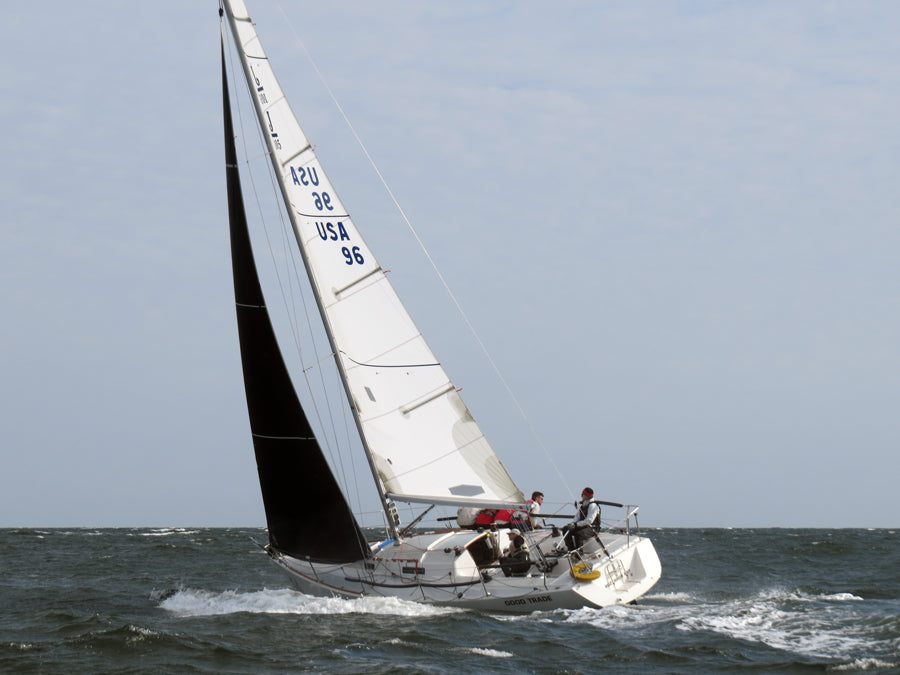
In breeze, the J105 jib is sheeted hard with the lead far enough aft to keep the leech open.
How do you trim the J105 main?
Again, we focus on halyard tension on the mainsail—it’s critical. Until it gets breezy, don’t over-tension the halyard; you should have diagonal wrinkles from the slides on the luff. Also, your outhaul should be tight.
Many people think they should always be streaming their top mainsail telltale, but because the top batten is full length, in reality it’s hard to stall the top. The sails are designed with a lot of twist in them so you can sheet hard as it gets windier. We recommend even in 8 knots that the top telltale should be stalled 60 percent of the time. The extra leech tension has the added benefit of pulling the headstay tighter, too, minimizing headstay sag.
The J105 doesn’t like much heel. From 11 knots up, our team is fully hiked, and at 15 knots, we’re pulling on the permanent backstay and tightening the cunningham. The backstay flattens the main well and begins to twist open the sail again, minimizing heel and weather helm. That’s the real trick on this boat. Set the rig tune so your trim and your backstay work for both sails at the same time. If the headstay gets too saggy and the main gets too flat, you probably don’t have enough cap and D2 tension.
The vang becomes critical in a breeze. In 8 to 10 knots, pull the vang snug. As the boat begins to get overpowered, pull it on firm. When using a lot of twist, it’s time for a two-hand pull, with feet against the cabinhouse. For the sake of your boom and mainsail, remember to ease the vang at the weather mark and let the cunningham off.
How do you shift gears upwind?
Besides hiking when the wind increases, shifting gears begins with adjusting the jib leads—moving the lead aft increases twist in the leech, which makes a big difference. The factory tracks have wide spacing between holes, so drill extra holes, one per inch.
You should quickly move to maximize outhaul on the mainsail, apply backstay as needed, and begin easing your traveler down in the puffs. Don’t hesitate to add a lot of vang tension so you can ease mainsheet instead of traveler; as a rule, the traveler car rarely moves lower or higher than the bench seats on either side of the cockpit.
Who says what when sailing upwind?
We like to have a crew on the rail calling the puffs consistently, so the main trimmer can be proactive in keeping the boat upright. Likewise, calling the waves allows for better steering and easing of sheets in lighter air. Dialogue between the helm and main trimmer is critical—and even more so when using a wheel because the driver is less likely to feel the pressure on the rudder.
The conversation when it’s windy is usually about having more or less twist in the sails. Is there too much helm and we’re going too slow? Twist the leeches. Not enough height? Reduce twist. The best sailor on many J105s is often the main trimmer because she is dialed in to both sail trim and boatspeed.

Keep weight forward and low when sailing a J105 downwind, with two crew forward of the shrouds in lighter conditions.
J105 Downwind Sailing
Where are J105 crew located?
Keep weight forward, out of cockpit. People also tend to stand a lot, but it’s faster to get down, keeping weight lower. On most boats, the main trimmer is at the companionway and the chute trimmer is at or ahead of the forward edge of the cockpit. All others move forward: in 0-8 knots, put two crew forward of the shrouds; in 9-16 knots, they can move just aft of the mast.
The boat likes to be sailed fairly flat and, ideally, the helm goes neutral. If it’s light enough that you’re sailing VMG angles, you’ll have some crew to leeward for a slight leeward heel. In running conditions of 10-plus knots, all crew will move to weather and sail the boat flat. Over 12, you sail with a little weather heel, and when control becomes an issue at 16-plus, the crew slides aft. In 20-plus, a couple guys are sitting in the cockpit.
How do you trim the spinnaker?
On a J105 downwind, the basic moves are to ease the chute as far as possible and rotate it in front of the boat as much as you can. The main should be all the way out and the vang kept soft.
The all-purpose and heavy-air spinnakers are the same size—the latter has bigger corner patches and a slightly different design to maximize projection. On both, the class-legal maximum luff is two feet short of ideal, so we generally sail with the tack line eased. This helps rotate the chute to windward—a good guide is not to ease it more than the height of the pulpit. As the breeze builds, you may trim down the tack line to within a foot of the pole.
The key to speed is the conversation and coordination between helm and trimmer. In light air, we look for an angle where the boat feels good, with slight heel to leeward. The mistake that people often make is to heat up the boat too much in lulls and soak it too low in puffs. You need to smooth that out. Yes, you do scallop your way down the course, but do it gently. The good guys gain a lot this way, and for everyone else, this is one of the best areas to practice and improve.
How do you shift gears downwind?
The key transition downwind is in 9 to 11 knots, learning when you can sail deep and when to keep the boat sailing higher and faster. The tack line on the spinnaker is a good focal point for this: If the tack moves to leeward of vertical, pull the tack line toward the pole; if to weather, ease it out, with a total range of two or three feet.
Another way to think of this is that in light air, when sailing VMG angles, the tack line is pulled towards the sprit and the main is trimmed for the angle. In medium air, when sailing deeper, the tack line is eased the most. Then, when control is an issue, tighten the tack line, which keeps the chute from oscillating.
Another downwind tip is to “fraculate”—taking slack out of the headstay by trimming in the sheets on the rolled-up jib. This firms up the backstay and transfers the energy in the sails more directly to the hull.
Near a leeward mark or at a finish line, you can also sail wing and wing, with the spinnaker on the opposite side from the mainsail. This takes practice and should be reserved for tactical situations, say the last five or six boatlengths to the mark. You can sail lower and just as fast, but don’t try it for extended periods; you risk collapsing the chute and losing more distance overall.
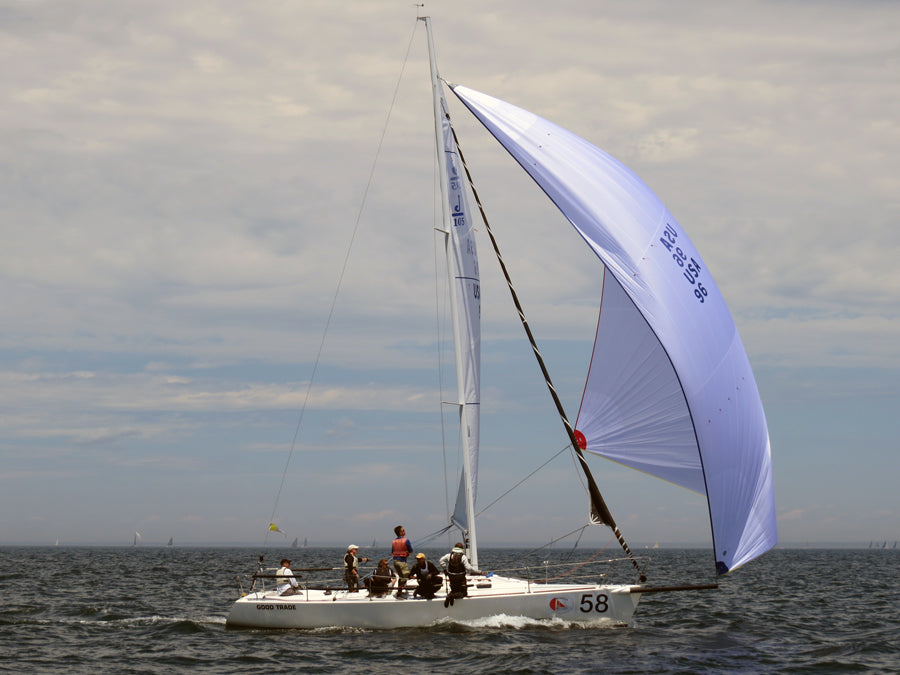
In 12 knots of breeze, most J105 crew stay out of the cockpit and at or just aft of the mast. To "fraculate" or keep the rig steady with backstay eased, tension the jib sheets to remove headstay slack.
J105 Boathandling
What are your top tips to starting well in a J105?
The J105 has a big keel and rudder, so you can sail pretty slowly before the start and not slide sideways much when you accelerate. However, the boat takes time to get up to speed. Practice accelerating from half speed to full speed before each race to learn how long it will take. Never let the boat stop or get too far from the line.
You’ll see many J105 teams wait to unfurl their jib in the last minute before starting, because visibility is better and, without a luffing jib, it’s easier to hold position on the line. When doing so, keep your bow at a fast angle to the wind so you can unroll the jib and accelerate quickly. The one time we never keep our jib rolled is when the wind is really light—if you get totally parked, the rest of the fleet may be long gone by the time you get moving.
What are the keys to tacking a J105 well?
Tacking the jib is pretty easy because it’s not a big sail, so you only need two trimmers in the cockpit. The other crew members go over the coach roof and keep their weight forward. This also gives the helmsperson more visibility.
How the trimmers work depends on whether your jib sheet 1) leads to a footblock and a leeward winch, 2) to a footblock and a windward winch, or 3) directly to a cabintop winch.
In light air, the cabin top winch set-up can be handled by the jib trimmer and the next person forward, and this has the advantage of keeping weight forward. However, those winches aren’t set up for breezy conditions.
We prefer sheeting to the primaries and having the main trimmer handle the jib-sheet release. The jib trimmer is the next person off the rail and trims the new sheet. This is also where cross-sheeting really pays as the jib trimmer is immediately moving to windward, not grinding away down to leeward. The main trimmer can then help out by dropping in the winch handle and doing the final trim after the jib trimmer starts hiking.
Most boats have self-tacking traveler cars. When tacking, the main trimmer can ease the mainsheet fine tune a little, release the jib, pull up the traveler, and then drop the handle in for the jib trimmer (if cross sheeting).
So the boat can accelerate, don’t bring the jib in too hard right away. Put multiple marks on the jib sheets to line up with the base of windward winch (if cross-sheeting), and after trimming to the first mark, the jib trimmer can hit the rail and the final five inches of jib sheet can be ground in by the main trimmer.
What are the keys to jibing a J105 well?
A good J105 jibe is a dance between the rates at which the driver turns the boat and the trimmer eases the spinnaker. As the boat bears away and the sheet is eased, the driver needs to watch the clew of the chute; when it gets to the headstay, the boat can be turned more quickly as the new sheet is taken up quickly. If you turn too fast without easing the sheet enough, or if you turn too slow, the chute ends up on the windward side of the headstay when the turn is complete.
On many boats, especially in lighter-wind areas, one trimmer will handle both spinnaker sheets. On other boats and in more breeze, it’s common to have two sheet trimmers for more consistency in ease and take-up. Either way, the foredeck person and sometimes others drag the new sheet around the headstay and aft. It’s important to pull the chute through the jibe this way to avoid a twist, then get to the high side quickly to help the boat accelerate. Keeping crew weight on the high side before the jibe will also help the boat turn.
In light-air jibes, don’t turn the boat too fast or pull the main across too soon. Jibe the spinnaker first. Then the mainsail trimmer should grab all parts of mainsheet and “pop” the main through to keep the upper leech from hanging up on the backstay. In heavy air, on the other hand, don’t take too long to get main across. Get it across while the boat is at full speed. Otherwise you may have to turn the boat too far to get the main over, and then you may round up when you finish the jibe. One helpful trick is to ease the vang a little bit.
How do you make a fast spinnaker set?
There are two rules to remember on J105 spinnaker sets: First, the bow must be at the windward mark before the bow person pulls the pole out to extend the sprit. Second, to set the spinnaker successfully, keep it out of the water by not pulling the tack line out too soon.
The bow person begins the set by freeing the chute from the forward hatch. Wait to start the hoist until the boat makes its turn. When it’s windy, as the mast person hoists, both the bow person and jib trimmer pull the tack line out to its mark. Next, the bow person can roll up the jib.
If a jibe-set is needed, there are two approaches you can take: one is to re-rig the chute on the correct side of the boat and hoist as the boat jibes. The other option is for the bow person to walk the clew around the headstay during the hoist, or even before you hoist.
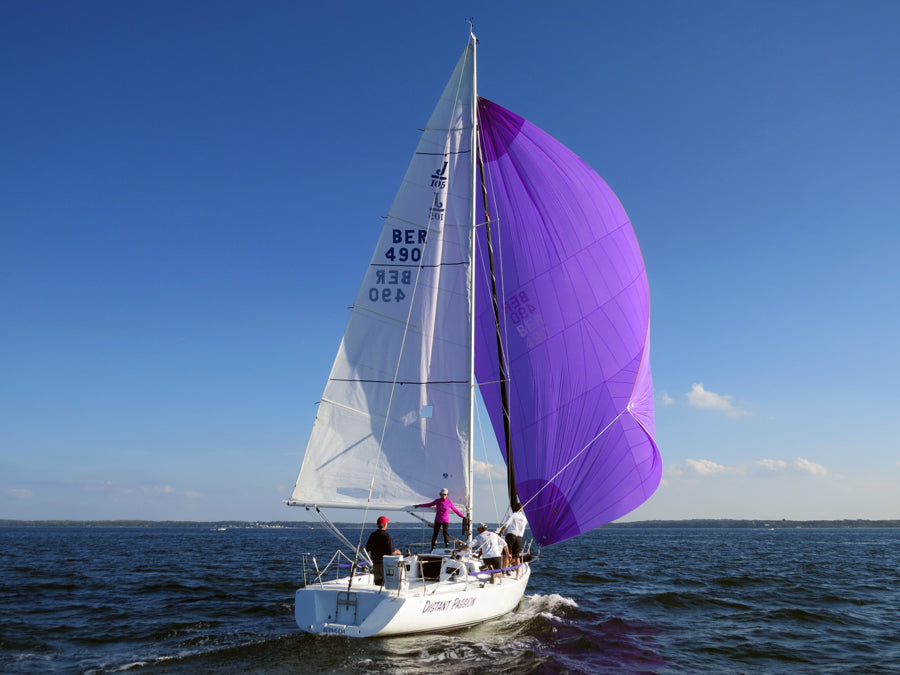
Sailing wing and wing with the spinnaker can be a useful tactical move; keeping weight forward in light air is always faster.
What are the keys to a good spinnaker takedown on the J105?
Most people douse the spinnaker to windward. Leeward drops are harder, in part because the chutes are wide and easy to shrimp (drop in the water). Either way, if you make sure to have room to turn the boat downwind, any takedown will become easier.
On a normal windward takedown, after the jib is unrolled, the helmsman bears off and the trimmer eases the spinnaker sheet. The bow person pulls (aka “tractors”) the clew around to the windward side of the jib as the halyard starts to come down. One crewmember stands below and pulls the chute through the forward hatch. If it’s windy, don’t blow the tack line too soon to keep the chute clear of the water—make sure the spinnaker is collapsing and that two crewmembers have a good grip on the material.
On a leeward takedown: the bow person grabs the lazy sheet and with the crewmember below pulls the chute under the jib and down the hatch. On these drops, don’t release the tack line until the sail decompresses and you’re able to pull the spinnaker straight down.
What are the most common takedown mistakes?
The most frequent error we see is simple—the spinnaker sheet isn’t eased enough so the bow person can’t pull the chute around the jib. The other one is also simple—if you do shrimp your kite, you must completely stop the boat before you can pull it back aboard.
How do you recover from a broach?
Most broaches don’t last long; once you ease the spinnaker sheet, the boat will pop back up. Remember to ease the main and the boomvang as you start to broach, and your recovery may be immediate.
What J105 best practices do you recommend?
Set daily objectives. Evaluate after sailing so you can step forward next time.
Identify crew responsibilities.
Mark everything so you can duplicate settings, especially jib leads and sheets.
Practice tacking and jibing; choreograph movements so you repeat them every time.
Document rig tune and settings.
What’s the coolest thing about the J105 class?
The J105 class is very friendly and well-organized.
You’ll find some really good technical sailors who know about rig tune and are willing to share knowledge. We recommend new people in the class find a more experienced buddy and ask if you can sail together at events. Watch, observe, ask questions, and you’ll improve steadily.


